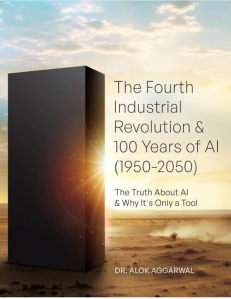Researcher and innovator Alok Aggarwal explores impact of the Fourth Industrial Revolution
and how it will evolve during the next three decades
— Alok Aggarwal
SAN JOSE, CALIFORNIA, USA, March 5, 2024 /EINPresswire.com/ — The sixth chapter of Alok Aggarwal’s new book, “The Fourth Industrial Revolution & 100 Years of AI (1950-2050),” explores the intersection of artificial intelligence (AI) and the global environmental crisis. As the Earth faces unprecedented climate challenges, a new chapter unfolds in the fight against climate change, and AI will play a major factor in the world’s response to the coming threats.
The comprehensive analysis, detailed in Chapter 6 titled, “Data and AI in Predicting, Mitigating, and Adapting to Climate Change”, explores the multifaceted relationship between climate change and AI. The following key topics are covered in this chapter:
• Since 1900, the world has become warmer by 1.2°Celsius: During 1980 and 2010, this global warming had already reduced Arctic Sea ice extent by one-third (i.e., from 7 to 4.67 seven million square kilometers).
• Continued global warming at the current rapid pace will be catastrophic: If left unchecked, the impending climate change will lead to (a) severe storms, which will cause flooding and landslides, (b) more wildfires, (c) increased drought and sandstorms, (d) warming and rising of oceans, (e) threatening coastal and island communities, (f) more heat related illnesses, (g) reduce the quality and quantity of fisheries, crops, and livestock, and (h) substantial human displacement and increased poverty.
• Substantial data is now being collected: This data from IoT devices (e.g., satellites, drones, and LiDARs) will help in not only training AI models better but also in improving traditional Physics models (e.g., computational fluid dynamics models) and simulation models.
• Collected data and AI techniques can help predict climate change: This chapter discusses six areas related to collation and harmonization of vast amount of collected data that are likely to provide better prediction models, especially when AI systems are combined with climatology models.
• Collected data and AI techniques can help mitigate climate change: This chapter considers six areas where new datasets and AI systems can help traditional models in mitigating climate change. These include estimating carbon sequestration to mitigate climate change, and helping researchers discover better materials that can absorb or adsorb carbon dioxide efficiently and inexpensively.
• Collected data and AI techniques can help adapt to climate change: This chapter considers four areas where additional data and AI systems can help in predicting extreme events including massive rainfall and snowfall as well as predicting the melting of ice sheets and sea level rise (so that people and businesses in coastal regions and islands can be moved gradually to higher ground.
• Using data and AI to improve conventional agriculture: This chapter provides the four areas where additional data and AI systems can help conventional agricultural industry, especially by optimizing production of crops, and minimizing agricultural losses due to post-harvest diseases.
• If left unchecked, electricity consumption for running AI systems can hurt climate change: The data being collected, and the AI algorithms being trained now require enormous amounts of electricity and rare-earth minerals. If this trend continues, then this combination may require around 30% of the world’s electricity supply in 2030, which would be disastrous since most of the electricity would be still generated by using fossil fuels (and hence contribute to greenhouse emissions).
Overall, the book, “The Fourth Industrial Revolution & 100 Years of AI (1950-2050)” provides a concise yet comprehensive exploration of AI, covering its origins, evolutionary trajectory, and its potential ubiquity during the next 27 years. Beginning with an introduction to the fundamental concepts of AI, subsequent chapters delve into its transformative journey with an in-depth analysis of achievements of AI, with a special focus on the potential for job loss and gain. The latter portions of the book examine the limitations of AI, the pivotal role of data in enabling accurate AI systems, and the concept of “good” AI systems. It concludes by contemplating the future of AI, addressing the limitations of classical computing, and exploring alternative technologies (such as Quantum. Photonics, Graphene, and Neuromorphic computing) for ongoing advancements in the field. This book is now available in bookstores and online retailers in Kindle, paperback, and hard cover formats.
About the Author: Dr. Aggarwal is the founder, CEO, and Chief Data Scientist of Scry AI, which provides innovative AI-based products, solutions, and services to enterprises across the globe. Before starting Scry AI, he co-founded Evalueserve (www.evalueserve.com) which provides research and analytics services worldwide. He received his Ph. D. from Johns Hopkins University and worked at IBM’s T. J. Watson Research Center during 1984 and 2000. He has written more than 120 research articles and has been granted eight patents.
About Scry AI: Scry AI is a research and development company that uses AI and Data Science to help its clients in solving complex and extremely laborious problems. Scry AI has developed more than 60 proprietary AI-based models and algorithms which constitute its CognitiveBricks platform of innovative business solutions. Scry AI’s family of enterprise solutions include: Collatio (an Intelligent Document Processing factory with unparalleled accuracy for reconciling unstructured and structured data), Anomalia (for detecting anomalies and potential fraud), Concentio (for providing actionable insights using Internet of Things’ data), Vigilo (for predicting operational and marketing risks), and Data Flow Mapping (for extracting data lineage as data flows through disparate systems). For more information, please visit: www.scryai.com
Alok Aggarwal
Scry AI, Inc.
+1 9149804717
email us here
Visit us on social media:
Facebook
Twitter
LinkedIn
Instagram
YouTube
![]()
Originally published at https://www.einpresswire.com/article/693192003/new-book-explores-the-role-of-artificial-intelligence-in-climate-change-prediction-mitigation-and-adaptation




